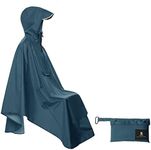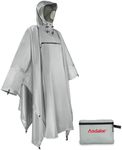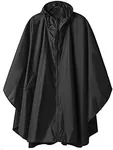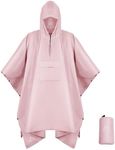Buying Guide for the Best Rain Ponchos
Choosing the right rain poncho can make a big difference in how comfortable and dry you stay during wet weather. A good poncho should protect you from rain, be easy to carry, and suit your activities, whether you're commuting, hiking, or attending outdoor events. When picking a poncho, it's important to consider the material, size, weight, design features, and how easy it is to pack. Understanding these key aspects will help you find a poncho that fits your needs and keeps you dry when it matters most.MaterialThe material of a rain poncho determines how waterproof, durable, and breathable it is. Common materials include plastic (like PVC), polyester, and nylon. Plastic ponchos are usually lightweight and inexpensive, but they can tear easily and may not be very breathable. Polyester and nylon ponchos are more durable and often have coatings to improve water resistance. If you need a poncho for occasional use, a simple plastic one might be enough. For regular use or outdoor activities, look for a poncho made from stronger, coated fabrics that can withstand repeated wear and keep you comfortable.
Waterproof RatingThe waterproof rating tells you how well the poncho keeps water out. This is often measured in millimeters (mm) and refers to how much water pressure the fabric can handle before leaking. Lower ratings (under 1,000mm) are suitable for light rain, while higher ratings (2,000mm and above) are better for heavy or prolonged rain. If you expect to be in heavy downpours or out for long periods, choose a poncho with a higher waterproof rating. For short trips or light showers, a lower rating may be sufficient.
Size and CoveragePonchos come in different sizes and shapes, affecting how much of your body and gear they cover. Some are short and just cover your torso, while others are long enough to protect your legs and even your backpack. If you want full protection, especially for hiking or carrying a bag, look for a larger poncho with extra length and width. For city use or quick trips, a smaller, more compact poncho might be easier to manage. Think about what you need to keep dry and choose a size that matches your activities.
Weight and PackabilityThe weight and packability of a poncho affect how easy it is to carry with you. Lightweight ponchos are great for travel and emergencies because they fold up small and fit in a bag or pocket. Heavier ponchos may offer more durability and features but can be bulkier. If you want something for unexpected rain or to keep in your backpack, go for a lightweight, packable option. For regular outdoor use where comfort and durability matter more, a heavier poncho might be worth the extra weight.
Design FeaturesDesign features like hoods, sleeves, snaps, and ventilation can make a poncho more comfortable and practical. A good hood with a drawstring helps keep your head dry, while sleeves or arm openings can make it easier to move. Some ponchos have snaps or zippers to close the sides, and ventilation openings to prevent overheating. If you plan to be active or wear the poncho for long periods, look for features that improve comfort and usability. For occasional or emergency use, a simpler design may be all you need.
Ease of Use and MaintenanceHow easy a poncho is to put on, take off, and clean can affect your overall experience. Some ponchos are designed to slip on quickly, while others may have more complicated closures. Consider how easy it is to shake off water, dry, and clean the poncho after use. If you want something for quick protection, choose a poncho that's simple to use and easy to care for. For frequent use, look for materials and designs that are easy to maintain and will last longer.

















